Exercises- Posture
My last post ‘The effects of slouching on the musculoskeletal system’ highlights some of the presentations seen in clinic that are predisposed by a slumping posture. Today’s post will explain a few exercises that focus on posture.
Introduction
The body is a ‘complex dynamic mechanism’ which is never still¹. Movement is a key part of sustainability for the body; frequent adjustment of resting position has been shown to be more beneficial than remaining in single postures for a prolonged duration². Antle et al (2018), demonstrated that sedentary sitting in the workplace has been associated with muscle pain, diabetes, cardiovascular disease and obesity³’⁴. Tudor- locke (2014) concluded that it is apparent that sedentary standing has no ‘cardiometabolic’ benefit compared with sedentary sitting in work environments that have implemented sit-stand desks⁵. Dynamic movement is optimal for overall health and reduces the elevation of muscle pain seen in those who swap between alternate sedentary patterns².
Muscle contraction during exercise encourages blood flow to the surrounding areas, maintaining oxygen and nutrient supply for healthy muscle and cell function⁶. Exercise also increases positive mood which is further enhanced in natural environments⁷.
The exercises
- Walking
Walking for between 15 and 30 minutes every day is excellent for general mobility, exercise and mood.
2. Chin Tuck
This exercise creates a positive response with my patients who experience neck and upper back pain.
This exercise allows a gentle stretch at the back of the neck and aims to strengthen the musculature at the front of the neck as well as articulating the joints of the neck and upper back.
✎ Keeping your head level, and imagining your head is in a box. Try to push your nose back so the back of your head touches the back of the ‘box’. You should form a double chin with this movement.
Hold for 3 seconds and then relax, repeat this 5 times.
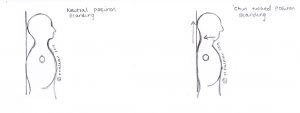
3. Shoulder rolls
This dynamic exercise is really good for patients with shoulder tension and neck stiffness. It allows you to use the muscles surrounding the scapular and encourages awareness of shoulder position when sat working for example.
✎There are a couple of variations of this exercise.
a. Keeping your arms relaxed by your sides, slowly bring your shoulders forward, then up towards your ears and back, making smooth circles.
Going backwards opens up the chest and encourages a more upright posture.

b) resting your hands on your shoulders take both elbows out in front, then up beside your ears and back round.
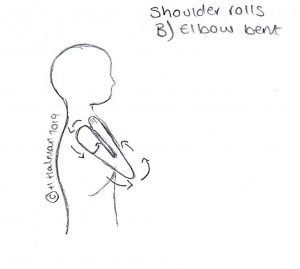
c) Full arm circles
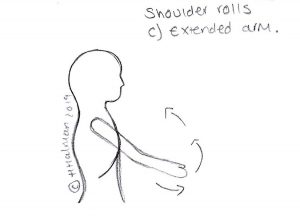
4) The figure of 8 / mid back exercise
This exercise is really good for general mobility of those small joints in your upper back. This might be useful if you have neck pain or lower back pain.
✎Interlace your fingers behind your neck, bring your elbows together. Slowly draw a big figure of 8 in the air. Ensure you reach the very top and the very bottom of the number. Take 10 seconds to complete one number. Repeat in both directions, 5 times each side.
Alternatively, in the same position, you can spell out your full name with your elbows.
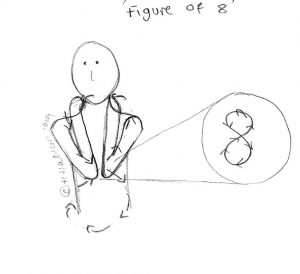
5) Global Range of motions exercises
These exercises encourage the range of motion throughout the spine, allowing a stretch and activation of musculature where needed.
a. Rotation
✎Seated or standing, look over one shoulder and slowly rotate your shoulders round to that side as far as you feel comfortable. Hold for 3 seconds and then slowly return to centre before repeating on the other side.
Alternate 6 times.
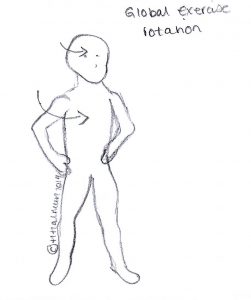
b) Sidebending
✎ Again, stood or seated. Drop your ear to your shoulder and allow that shoulder to point down towards the floor to create a nice side-bend to the back. If you would like to increase the stretch you can take the opposite hand up over the head.
To add a stretch to the intercostals (muscles between the ribs) when in the side-bent position take a controlled breath in, hold for 3 seconds and breath out and relax to a neutral upright position.
Alternate 6 times.
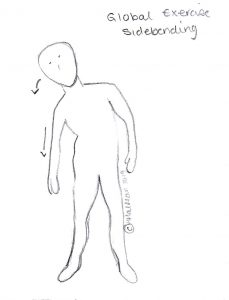
6) Hip circles
The exercise is useful for individuals with tight hips and lower back pain. It allows movement of the hip and pelvic joints, as well as stretching and activating muscles in the surrounding area.
✎Standing with legs hip-width apart, and with something nearby for balance.
Bending the knee, in a controlled manner bring your knee up towards your chest, take the knee out to the side and then slowly back round to place back on to the floor.
Alternate 6 times.
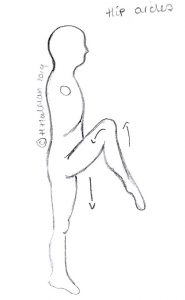
7) Cat/ Cow
This exercise allows controlled movements through the lower back and mid back. Encouraging the range of motion in flexion and extension.
✎Kneeling on the floor on your hands and knees. Knees hip-width apart and hands shoulder-width apart.
Starting with a flat back, push your tailbone and top of the head down towards the floor. Imagine each segment of your spine slowly following creating a nice curve of the spine. Ensure that you relax your neck in this position.
Hold for 3 seconds
Leading with the top of your head, slowly start to look up, be careful not to extend the neck too far, gently allowing the mid back and lower back to arch.
Hold for 3 seconds and then repeat 4 times.

If any of these exercises cause any discomfort, stop doing them and contact your osteopath.
Take care,
Hermione
References
1. Parker, S. The human body book. A penguin company, London. 2007; 17-18.
2. Antle, DM, Cormier, L, Findlay M, Miller, LL, Cote JN. Lower limb blood flow and mean arterial pressure during standing and seated work: Implications for workplace posture recommendations. Preventive medicine reports. 2018; 10, 117-122.
3. Buckley JP, Hedge A, Yates, T. The sedentary office: a growing case for change towards better health and productivity. Expert statement commissioned by Public Health England and the active working community interest company. Br. J Sports Med. 2015; 49, 353-1353
4. Wilmot EG, Edwardson CL, Achana FA. Sedentary time in adults and the association with diabetes, cardiovascular disease and death: a systematic review and meta-analysis. Diabetologia. 2012; 55,2895-2905
5. Tudor- Locke, C, Schuna JM, Frensham LJ, Proenca M. Changing the way we work: elevating energy expenditure with workstation alternatives. Int J Obes. 2014; 38,755-765.
6. Bangalore-Yoganda, C, G, Rosenberry, R, Soni, S, Lui, H, Nelson M, D and Tian, F. Concurrent measurements of skeletal muscle blood flow during exercise with diffuse correlation spectroscopy and Doppler ultrasound. Biomedical optics express. 2018;9(1): 131-141.
7. Snider R. M. Influence of exercise environment on stress and affect in sedentary adults: A comparison of indoor and natural environments. 2018; UVM honours college senior thesis. 231.

Leave a Reply
You must be logged in to post a comment.